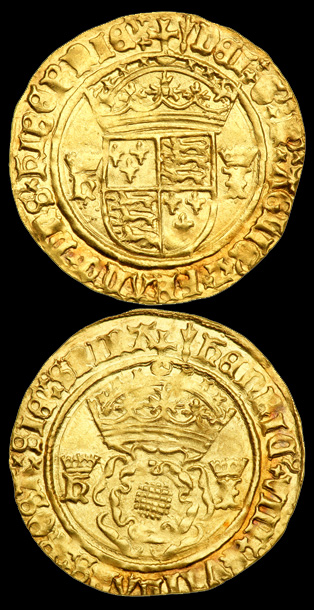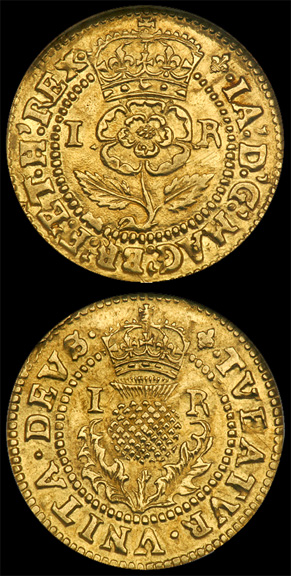English Gold Coins:
English Gold Coins (overview) | Gold Penny | Gold Florin | Gold Noble | Gold Ryal | Gold Laurel | Gold Unite | Triple Unite | Gold Crown | Gold Angel | Gold Guinea | Gold Coins Of The Black Prince | Five Guineas | Gold Sovereigns | Fine Sovereign | Double Sovereign | Two Pound Coin | Five Pound Coin | Gold Proof Coins | Elizabeth II Diamond Jubilee Gold Coins
Gold Crown
Share this page:

Crown Of The Double Rose (S.2279).
Henry VIII (1509-1547)
Obv. - Crowned double rose.
Rev. - Crowned shield.
Crowned letters H and I on both sides stand for Henry and Jane Seymour issue (1536-1537).
Arrow or pheon mintmark (top). 3.67 grams.
Image by kind permission of:
Ira & Larry Goldberg Auctioneers Inc.
Although many people think of the English crown coins as being minted only in silver, the first crowns were made of gold. The first gold crown was introduced in the Second Coinage of King Henry VIII - from 1526 to 1544.
Crown Of The Rose
The first crown coin was called the Crown of the Rose. It was made from 23 carat gold and valued at four shillings and sixpence. However this coin was short lived. Two varieties are listed in coin catalogues; one with the reverse legend DNS HIB [short for "Dominus Hibernia"] RUTILANS ROSA SINE SPINA ("Lord of Ireland a dazzling rose without a thorn"); the other with HENRIC RUTILANS ROSA SINE SPINA of the reverse legend ("Henry a dazzling rose without a thorn"). Both of these coin types are very rare and valuable now. [1]
Crown Of The Double Rose
Henry's next gold crown, the crown of the double rose (see image left), was valued at five shillings - and this has remained the face value of the crown ever since (with the exception of the commemorative "crowns" issued from 1990 onwards which have a face value of five pounds).
The crown of the double rose was minted at 22 carat - and unlike some of Henry's controversial silver coins, the gold crowns were never debased. Numerous varieties appeared: As is well known Henry remarried several times, with one of the results being that the "HK" on the first coin, short for "Henry Katherine" needed to be amended several times! A half crown was also issued and these coins were successful, being continued with the Third Coinage (1544-1547) and Posthumous Coinage (struck from 1547-51 during the reign of Edward VI yet with Henry's name and portrait). [2]
Edward VI Crowns
Edward VI (1547-1553) continued to mint gold crowns together with half crowns, and also introduced a silver crown. None of the gold crowns of Edward VI is common - and the first issue is thought to be unique.
Elizabeth I Crowns
Mary and Philip did not mint crowns, however both silver and gold crowns and half crowns were re-introduced by Elizabeth I. None of the gold crowns of Elizabeth are common and of the first of the three issues, only two examples are known to exist.
Gold and silver crowns were subsequently minted by James I, Charles I and during the Commonwealth period.
Britain Crown
The gold crown minted during the second coinage of James I came to be known as the "Britain Crown." This was because the words MAG BRIT ("Master of Britain") appeared on the coins for the first time. The crowns of James's third issue were also known as quarter laurels, a laurel being a twenty shilling gold coin of the same period.

Gold Florin of 1344 (S.1476)
King Edward III with scepter and orb. 6.986 g
Thistle Crown
James also introduced the thistle crown (see image left) - a smaller gold coin valued at four shillings, however this coin was not continued by later monarchs. [1] The Thistle crown featured a rose and crown on the obverse, and thistle-and-crown on the reverse. The letters IR (standing for 'IACOBUS REX')appear on either one or both sides of some coins, and not on others.
Double Crown
James I, Charles I and the Commonwealth also produced double crowns, valued at 10 shillings.
Gold Proof Crowns
From the time of Charles II onwards, regular-issue crowns were minted in silver - however there have been occasional gold proof crowns or pattern crowns created as presentation pieces. In general these coins are spectacularly rare and valuable; worth high five figure 5 or even 6 figure sums in some cases. Dates include:
1658 Cromwell crown (8 over 7, struck in gold, similar in design to the silver 1658 crown). Catalogue price £75,000.
1663 Proof in gold. Catalogue price £40,000.
1817 "Three Graces" pattern-only gold crown; not listed in catalogues. Three in existence - one sold in 1999 for a then-record £170,500.
1825 Proof or pattern in "Barton's Metal" (copper overlaid with a thick layer of gold) - catalogue price £3,500
1831 Proof in gold, edge plain. Catalogue price FDC £85,000
1847 Gold proof gothic crown. The only one available to collectors of this legendary coin sold in July 1988 for £120,000.
1935 Jubilee Crown. (S.4050) Only 28 of these were struck in gold, weight c. 48 grams, raised edge lettering. Catalogue price £20,000
Elizabeth II Gold Crowns
Since 1990, commemorative gold proof "crowns" with a face value of five pounds sterling have been issued by the Royal Mint. These coins, issued as limited edition collector's pieces, have been referred to as "five pound crowns" in order to distinguish them from "quintuple sovereigns." The five pound crowns have a diameter of 38.61mm, a weight of 39.94 grams and a fineness of 916.6 (22 carat). [3] See Five Pound Coin for a full list.
References:
[1] Coincraft's Standard Catalogue of English and UK Coins (1998 ed.)
[2] Spink - Coins of England and the United Kingdom
[3] http://www.taxfreegold.co.uk/fivepoundsinfo.html




